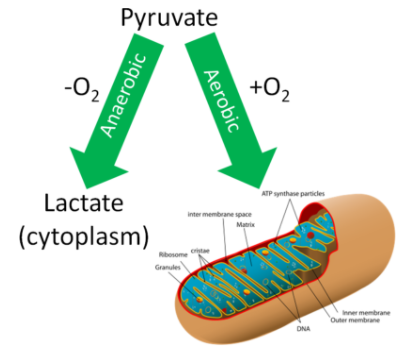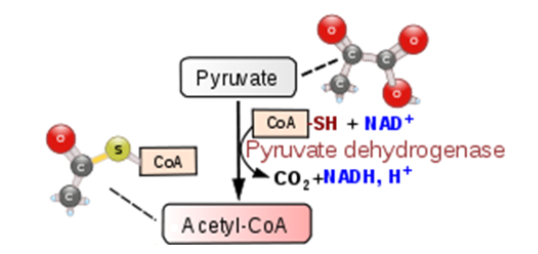17.3.2: Transition Reaction from Pyruvate into Acetyl CoA (keep!)
- Page ID
- 36332
Pyruvate is transformed into Acetyl CoA
Glycolysis began with the entry of one six-carbon molecule of glucose that now produced two three-carbon molecules of pyruvate, with a net gain of two ATP molecules, two coenzyme molecules in the form of NADH, two hydrogen ions (which enter the electron transport chain), and two molecules of water.
In the following metabolic pathway the newly formed pyruvate as it is transformed into acetyl CoA.
Acetyl CoA is often called the “gateway” molecule for aerobic metabolism because all energy-producing nutrients—glucose, amino acids, fatty acids, glycerol, even alcohol—are usually transformed to acetyl CoA before entering the so-called tricarboxylic acid cycle (a.k.a. TCA cycle). Until this point along the metabolic pathway, energy is produced anaerobically. When cells contain an ample supply of oxygen, pyruvate now continues down the aerobic energy pathway to create acetyl CoA.1
In the presence of oxygen, the two molecules of pyruvate formed during glycolysis cross the outer mitochondrial membrane and enter the mitochondria, where they each lose a carbon. Next, coenzyme A, an organic compound synthesized from the B vitamin pantothenic acid, attaches to the remaining two carbons from each pyruvate molecule to form acetyl CoA (see figure 9.3.5.1). Thus a three-carbon pyruvate molecule is changed into a two-carbon acetyl CoA. The third carbon combines with oxygen to form carbon dioxide and is expelled through the lungs as waste.1
Accordingly, if a person is in a catabolic state or needs energy, the way how pyruvate will be used depends on whether adequate oxygen levels are present. If there are adequate oxygen levels (aerobic conditions), pyruvate moves from the cytoplasm, into the mitochondria, and then undergoes the transition reaction. If there are inadequate oxygen levels (anaerobic conditions), pyruvate will instead be used to produce lactate in the cytoplasm.

Figure 9.3.5.1 Pyruvate fork in the road. What happens depends on whether it is aerobic or anaerobic respiration2
The transition reaction is the gateway transition between glycolysis and the citric acid cycle. The transition reaction converts pyruvate (3 carbons) to acetyl CoA (2 carbons) while producing carbon dioxide (CO2) and NADH as shown in figure 9.3.5.2 below. Figure 9.3.5.2 illustrates the transition reaction that combines pyruvate with CoA and NAD entering to produce acetyl-CoA, CO2, and NADH.

Figure 9.3.5.2Transition reaction3
Thus, the transition reaction produces 2 acetyl-CoAs, 2 molecules of CO2, and 2 NADHs from one molecule of glucose!
Contributors
References & Links
- Blake, J. S., Munoz, K. D., & Volpe, S. (2019). Nutrition: From Science to You (4th ed.). Pearson.
- simple.Wikipedia.org/wiki/Mi..._en_(edit).svg
- en.Wikipedia.org/wiki/Image:C...conitate_2.svg
- en.Wikipedia.org/wiki/Image:Coenzym_A.svg

